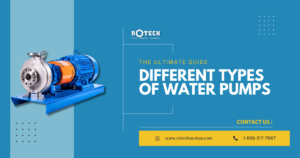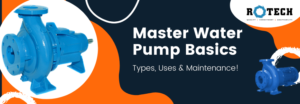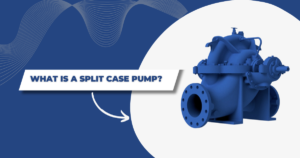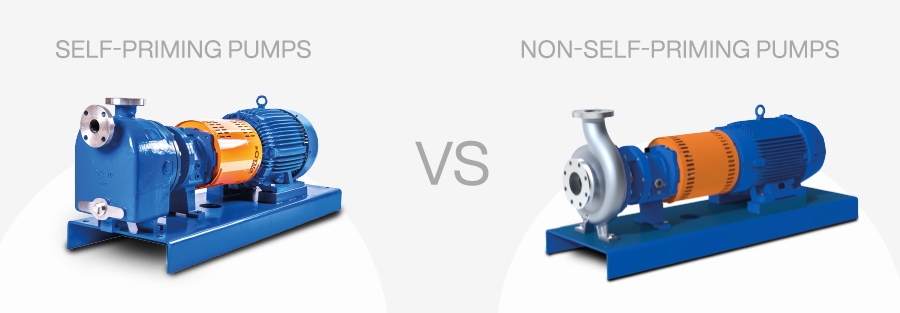Rotech manufactures various pumps for various industries and applications. We are the pump people. Our inventory includes numerous types of pumping systems that are highly effective and thoroughly tested. We stand as one of the most efficient ANSI pumps, self-priming pumps, and end-suction pump manufacturers. Among our various centrifugal pumps are self-priming pumps.
This article will explore the prime difference between self-priming pumps and centrifugal pumps. But before understanding the difference, we shall understand more about self-priming pumps and their operation.
Self-priming pumps are liquid pumps designed to have the required liquid inside the cavity or pump body necessary to start the pumping process. These are self-priming centrifugal pumps with the benefits of a compact design, practical use, simple maintenance, high efficiency, and a powerful self-priming capability. They offer convenience and efficiency in process plants and industries where pumps get used for various repetitive operations.
Self-priming pumps are liquid pumps designed to have the required liquid inside the cavity or pump body necessary to start the pumping process. These are self-priming centrifugal pumps with the benefits of a compact design, practical use, simple maintenance, high efficiency, and a powerful self-priming capability. They offer convenience and efficiency in process plants and industries where pumps get used for various repetitive operations.
So How Does a Self-Priming Pump Work?
Self-priming pumps have the required start-up liquid in their chamber or body. They create a partial vacuum to discharge water to avoid mixing air and water. They combine the air and water during the priming process to force the air to rise and the water to go down. The air-free water is then pulled back into the impeller due to gravity and mixed with the remaining air in the suction line.
The above process repeats until all air gets evacuated and a vacuum gets created in the suction line. After these processes, atmospheric pressure pushes the water into the suction line and towards the impeller, and the pumping begins. Self-priming centrifugal pumps overcome air binding by mixing any remaining air at first in the working mechanism with fluid during the priming process.
Difference Between Self-Priming Centrifugal Pumps and Centrifugal Pumps
Non-self-priming Pumps
- Standard centrifugal pumps or non-self-priming pumps do not get designed to be self-priming.
- They move the water by the method of centrifugal force. The liquid enters the pump through its suction inlet. It gets separated by one or two impellers and then driven towards the pump discharge.
- Therefore, the priming is done manually and made sure that the pump primes it is put into operation, so the intake pipe must always be full of liquid.
- They are simple, sturdy, and relatively cheaper than self-primer pumps. We carry a varied experience as ANSI centrifugal pump manufacturers. You can take a glance at our centrifugal pumps for more insight.
Self-Priming Pumps
- Self-Priming pumps do not require any manual procedure. They can prime on their own.
- They have a notable design that features an in-built liquid reservoir, ideally either above or in front of the impeller.
- These pumps do not require a foot valve. During the priming cycle, the reservoir enables the pump to remove air from the pump body and suction line and replace it with liquid blended with any remaining air.
- The self-priming centrifugal pumps can retain the liquid in the pump. For more insight, browse our series of self-priming pumps.
Applications and Advantages of Self-Priming Pumps
- The self-priming pumps can handle a variety of liquids like water, wastewater, sewage, and slurries.
- They will continue pumping liquids even after the pump is no longer submerged in a liquid tank or vessel.
- These pumps are ideal for frequent and repetitive pumping operations. They are efficient, convenient, and time-saving.
- Self-priming pumps can readily get used for various liquids in agricultural, construction, domestic, and industrial applications.
- Self-priming pumps get used in various industrial and commercial facilities, from steel mills, power plants, and sewage treatment facilities to wineries and breweries. Some more applications include pumping water, fuels, raw sewage, and industrial wastewater, and get applied in sewage treatment, irrigation, liquid transfer systems, and cleaning.
Rotech Self-Priming Pumps
Rotech strives to provide the best quality products at competitive prices with minimum lead time. We have been manufacturing ANSI process pumps, ANSI pumps, and a massive range of pumps since 2003. We have an efficient series of self-priming pumps in our portfolio.
1796 Series Self Primer Pumps
- 1796 Series ANSI Self priming pumps are designed with semi-open impellers and used in various heavy-duty industrial applications.
- Rotech ANSI Self-priming pumps are directly interchangeable with other ANSI Self priming pumps, Goulds 3796 and Summit 2796.
1796CC Series Close Coupled Pumps
- Rotech 1796 Series Self Priming ANSI Close Coupled Pumps are designed to provide an option for ANSI Self Priming Frame-mounted pumps. The Liquid End Pump parts are coupled with NEMA C Face Electric Motors.
- This series uses the same hydraulic pump casing, impeller, and stuffing box cover as the regular ANSI Self-priming pump series.
SCP Series Close Coupled Pumps
- SCP series pumps are End suction self-priming pumps designed for pumping water, wastewater, and light slurry liquids.
- The pumps are End suction self-priming pumps with horizontally mounted & back pull-out designs. The pumps get supplied in 1.5”x1.5”, 2”x2”, and 3”x3” size with NPT threaded connections.
SFP Series Frame Mounted Pumps
- SFP series pumps are designed for pumping water, wastewater, and light slurry liquids.
- The pumps are End suction horizontally mounted in, and a back pull-out design. The Pumps get supplied in 1.5”x 1.5”, 2”x 2”, 3”x 3” sizes with NPT threaded connection.
SPT/SXT Solid Handling Trash Pumps
- SPT/SXT series pumps are self-priming pumps with two vanned opened impellers designed for economical & trouble-free operation in solid handling sewage & slurries.
- SPT is a regular Self-priming Pump interchangeable with Gorman Rupp T series pumps while SXT is a super Series Self priming pump interchangeable with Gorman Rupp Super T Series Pump.
SPU /SXU Series High Head
- SPU/SXU series pumps are self-priming pumps with multiple vanes opened impellers designed for economical & trouble-free operation in solid handling sewage & slurries.
- SPU is a regular Self-priming Pump interchangeable with Gorman Rupp U series pumps while SXU is a super Series Self priming pump interchangeable with Gorman Rupp Super U Series Pump.
Rotech pumps are highly effective and thoroughly tested. We put more weight on research & development and trying & testing. We strive for your reliability on us for all your pumping needs. Check our Products Portfolio for comprehensive information on self-priming pumps, their types, features, design specifications, and applications.
Recent Posts

A Comprehensive Guide to Types of Water Pumps and Their Applications
Introduction Water pumps are indispensable

The Complete Guide to Water Pumps: Types, Uses, and Maintenance
Water is life, and the

Comprehensive Guide to Split Case Pumps
Split case pumps are a


